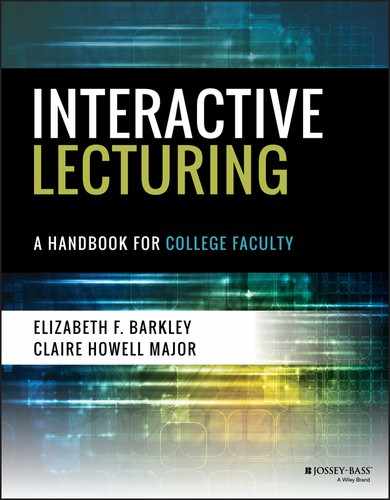ACTIVE LEARNING TECHNIQUE 24
Real-World Applications
| Complexity involved in | |
| Planning | MODERATE |
| Developing Materials | MODERATE |
| Implementation in Class | LOW |
Description and Purpose
After hearing about an important principle, theory, or process, students have to develop Real-World Applications of what they have just learned. This activity pushes students to deeper levels of understanding of a topic by requiring them to identify the topic's underlying qualities and then generate a novel and reasonable application. Its value as an instructional activity lies in the way it challenges students to move beyond surface thinking. It is also a useful assessment because it reveals how well students understand the concept as well as how creatively they can transfer their understanding of the elements to a new context. In addition, it helps students see the relevance of what they are learning.
Preparation
- Choose a topic that is important to your course or academic discipline that students have studied in some depth.
- Reflect on the topic yourself and identify a number of ways the underlying concepts could be applied in a new context to ensure that the topic is sufficiently generative and to determine how much time to allow students to do the assignment. Choose one or two that can be used to provide models to students. (When you repeat this assignment in a subsequent class, consider using student examples as models.)
- Create a prompt such as the following:
“Based on your understanding of the scientific process, identify at least one application for it in a novel context. Here is one example students generated last academic term: ‘In the scientific process, scientists formulate a question, develop a hypothesis, predict a logical consequence of the hypothesis, then test their conjecture and draw conclusions that they share with others. This same process could be used by detectives who are investigating a crime, and the information they gather along with their findings could be judged in a court of law.’ ”
- Decide whether you want to assign this as an individual or group assignment.
- Create an assessment rubric that includes elements such as quantity, novelty, and appropriateness.
- Decide how long to spend on the assignment (typically three to five minutes) and how many applications students will generate (one to three is ideal).
- Determine how students will submit responses. You may want them to turn them in on index cards or you may simply want to ask for volunteers to share orally.
Procedures
- Announce the activity, the time frame, and how students should share their responses with you.
- Ask students to begin work.
- Collect the responses.
| Online Lecture | Large Lecture |
| If you have decided to use this as an individual assignment, simply create an open-ended assignment or post as a discussion. To make it a group assignment, consider forming students into groups and assign each group its own private discussion area so that members can communicate their ideas. At the deadline, have groups communicate their ideas to the whole-class discussion thread. | Limit students to one application and either choose students randomly to report out or ask for volunteers. Alternately, ask them to turn in their responses on an index card that you can assess with a simple plus-minus. |
Examples
Geography and Globalization (Lecture)
The professor wanted to assess student understanding of the push-pull factor that they had been studying in relation to human migration. She organized students into small groups and challenged them to generate as many examples as they could of how the factor's underlying principles of opposing forces could be applied in non-geographical contexts.
Introduction to Inorganic Chemistry (Large Lecture)
The subject of this course is the laws, theories, and concepts of chemistry. Students also learn about methods of writing formulas and equations. The professor wanted students to understand aspects of chemistry as they take place outside of the laboratory. For a unit on atoms, electrons, and ions, he asked students to develop clicker questions designed to test the material learned in class, but set in Real World Applications. He asked them specifically to focus their questions on chemical bonding. To complete the assignments, students had to think about chemistry beyond the classroom and consider the Real-World Applications of what they had learned. Students then reviewed each other's questions to help refine them, which the professor thought exposed students to the notion of peer review.
Music History: Eighteenth-Century Classicism (Video Lecture)
A core concept in this blended course is the sonata-allegro form because this form is the basis for first movement formal organization in classical symphonies, concertos, string quartets, piano sonatas, and so forth. To ensure students fully internalized the structure of the form, the professor assigned Real-World Applications to the base groups she had established at the beginning of the term, presenting it as the prompt for each group's private discussion area and instructing groups to create three applications to novel contexts. At the deadline, students shared their ideas with the whole class on the public forum.
Variation and Extension
- Review the results and share the best responses with the class. This extension will enable students to learn from each other, which can be motivating for them.
Observations and Advice
Although many students will find this technique challenging and fun, those students who do not understand the underlying topic sufficiently or cannot generate an application in a novel context may find it too difficult and get frustrated. Working in small groups will help support such students, but if the assignment is graded, ensure that your assignment process and evaluation rubric address individual accountability.
This technique can help students to understand the real-word uses of the information they are studying, and thus it can improve their motivation and engagement.
Key Reference and Resource
- Angelo, T. A., & Cross, K. P. (1993). Classroom assessment techniques: A handbook for college teachers (2nd ed.). San Francisco, CA: Jossey-Bass.
